
Last Updated on 27/09/2022 by Above Diamond
Last Updated on 01/10/2022 by Wit Sudjaiampun
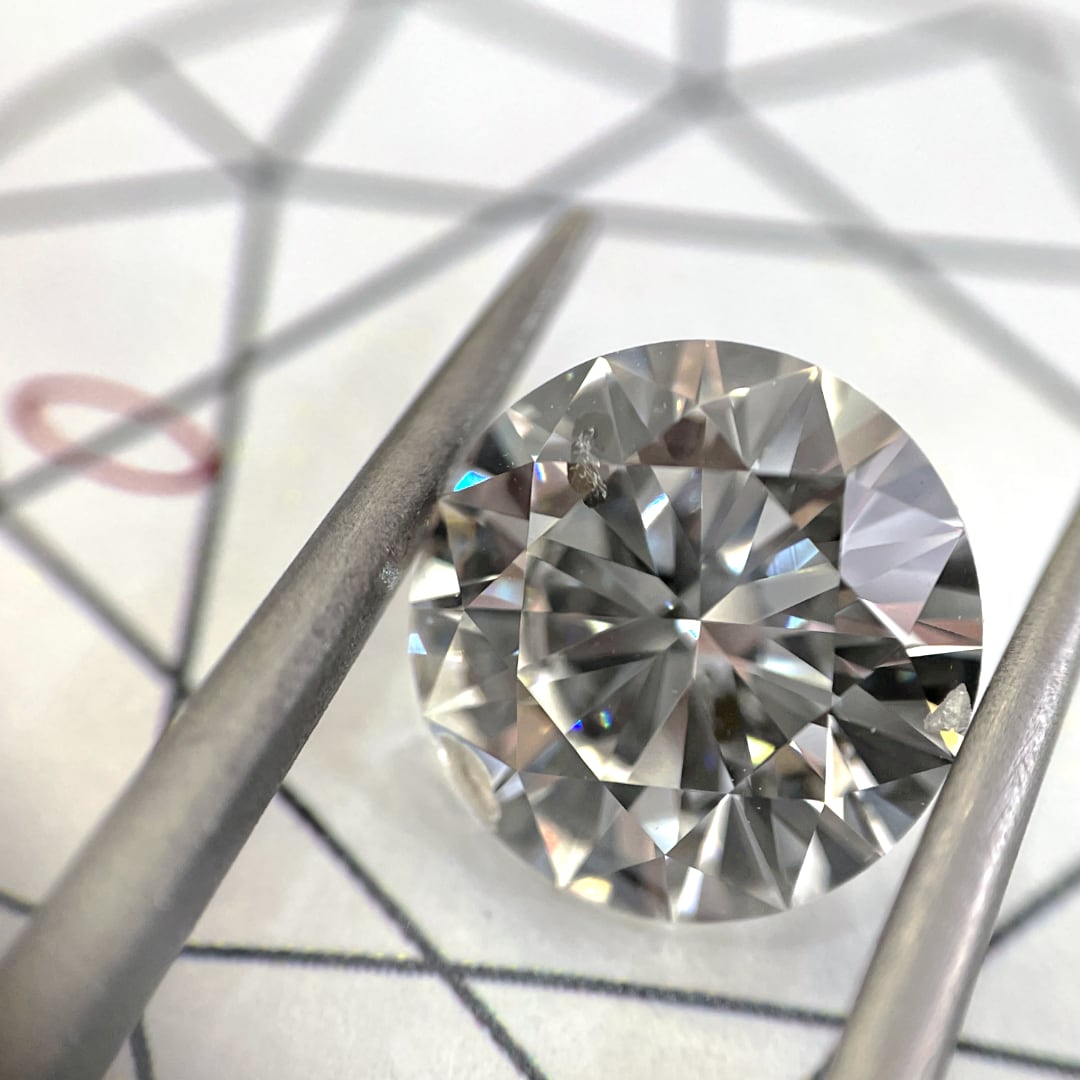
If you are purchasing your diamonds based on its Clarity (VVS VS SI) on the diamond report, you might be missing out on the smaller but crucial details that are the Clarity Characteristics.
When it comes to diamond flaws or clarity, you might already have already known that it is one of the 4Cs of Diamondwhich is used to evaluate the beauty and value of diamonds.
If you are someone who loves collecting beautiful diamonds but has, to an extent, a large budget, you should consider buying diamonds that have the clarity level of IF, VVS1, VVS2, VS1, or VS2 but for those of you who have a limited budget or if the diamond’s beauty is not your priority – you should consider buying diamonds with the clarity level of SI1, SI2 or lower.
If you are a person who likes to look for real diamonds and are just beginning to learn about clarity, I recommend you read the article “Facts you should know about IF, VVS, VS, SI clarity diamonds”
But that is only just the tip of the iceberg as many of you know. Even though different levels of clarity will affect the pricing of a diamond, it does not mean that diamonds of the same clarity, VVS2 for example, will have the same price.
That is because the finer details under the “Clarity” topic, the “Clarity Characteristics”, will tell us the story and source of the diamond. Yet, this is not mentioned often.
In this article, I will explain to you the 11 types of Clarity Characteristics and the 5 types of Comments. These are important details that will affect both the beauty and the value of the diamonds you wear.

Clarity means the flaws of the diamonds that occur naturally, there are external flaws (blemishes) and internal flaws (inclusions). These flaws are called “Clarity Characteristics” in the GIA Diamond Report. In simpler terms, they are the type of flaws a diamond has.
Flawless diamonds with clarity levels such as “Internally Flawless” or “IF” are diamonds that have no visible flaws even under a 10x magnifier. These diamonds make up only 0.5% of the population of all the diamonds on Earth and so they are popular with the “Purists” who, as their name suggests, have high budgets. Because of its rarity, these diamonds have a huge price leap from the VVS1 Clarity level diamonds.
The higher the clarity level, the fewer flaws on the diamond (IF > VVS1 > VVS2 > VS1 > VS2) and so they are more valuable.
However, that does not mean that higher clarity level diamonds will have better brilliance (unless the flaws directly affect the beauty of the diamond itself) because a diamond’s brilliance depends on the “Cut Quality” (3 Excellent, Proportions Percentage, and Hearts and Arrows)
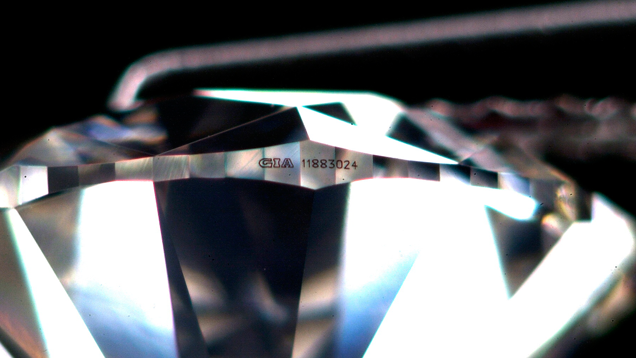
Clarity Characteristics, or the types of flaws a diamond has, are considered a main element of which a real and natural diamond gains its charm.
Because lumps of diamonds are formed under the deep surface of the Earth, it is natural that the flaws of the diamonds will be hidden within the diamonds. But that is only the beginning, other than natural factors, humans also play an important part in the process of mining and cutting diamonds. This is an important factor that will affect the beauty of each diamond gem.
As we all know well, each diamond will have its own unique characteristics and story – that is why no diamonds on Earth will be 100% similar. We can consider the flaws of a diamond as its fingerprints, it enables us to distinguish each diamond easily and precisely.
Suppose we were choosing between two diamonds, both diamonds have a clarity level of VVS2 – this does not mean that both diamonds will be equally beautiful. Each diamond will surely have its own details and flaws that are different.
Because each diamond is different in clarity, purchasing diamonds based on the contents of a diamond report without seeing the real diamond is like crossing the streets with your eyes closed. It is risky and you will never know what the flaws look like and how much it affects the beauty of your diamond.
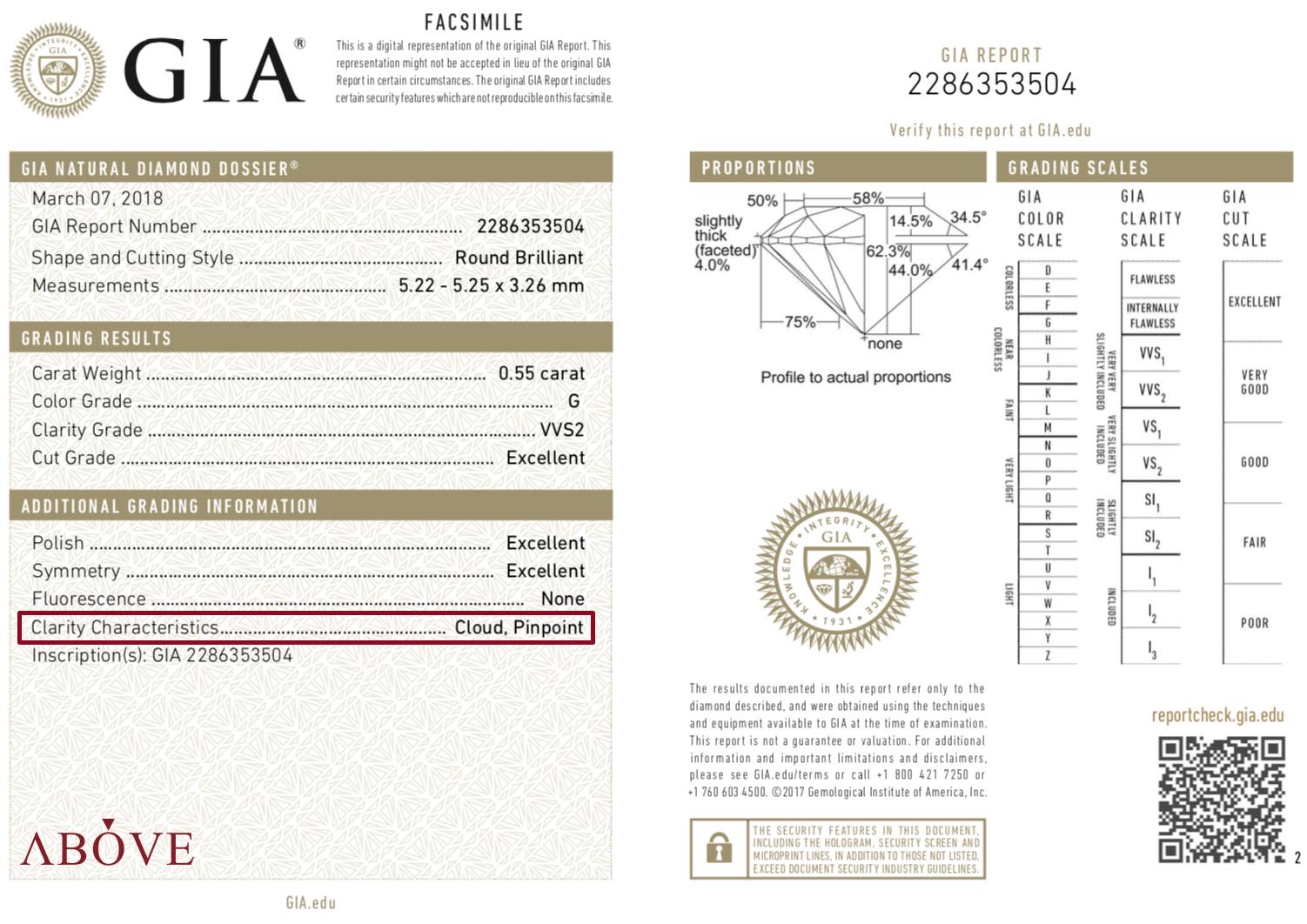
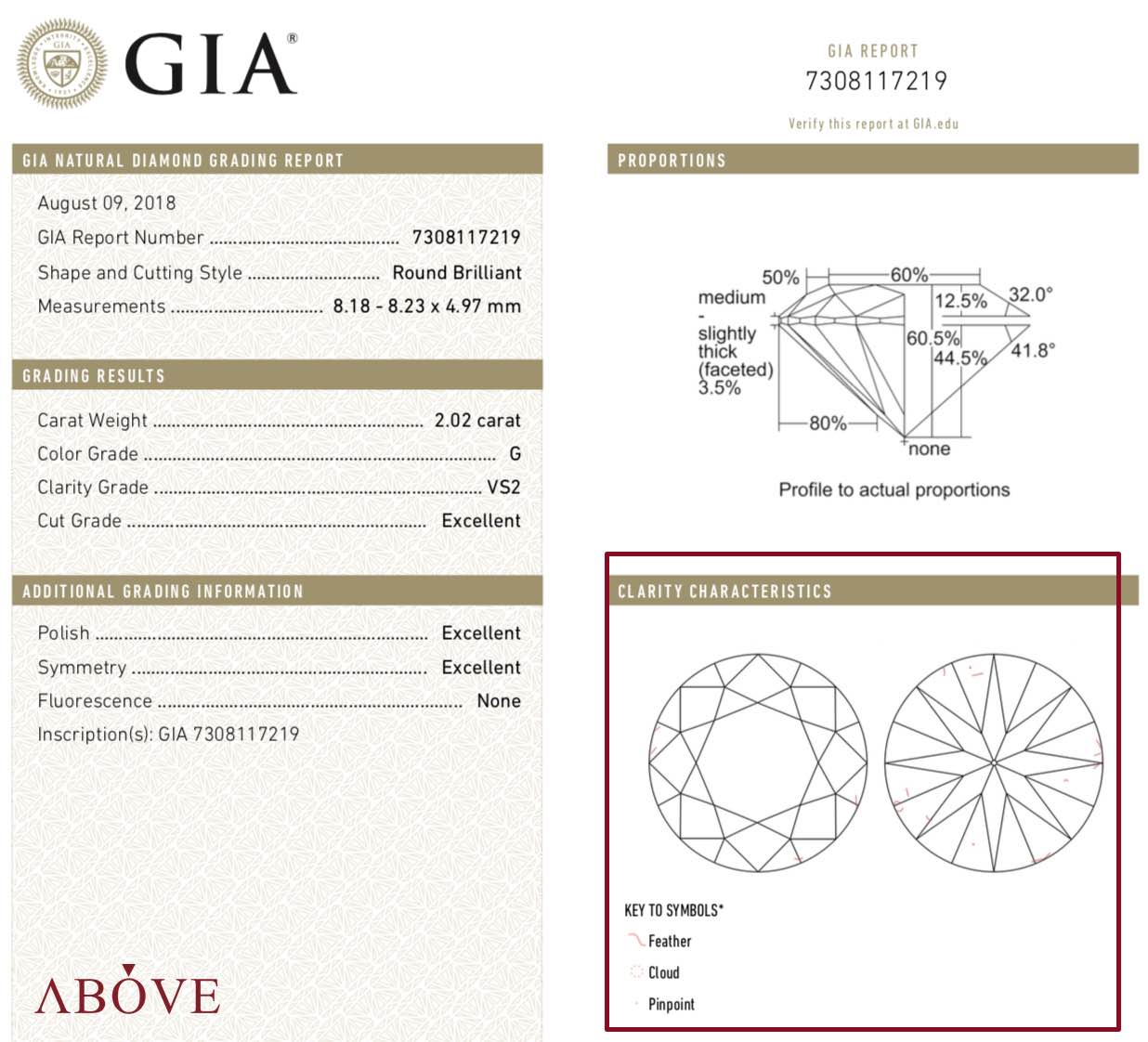
In the diamond quality assessment process, the clarity characteristics are analyzed in detail by gemologists so that they are able to mark all the locations and types of flaws.
But because different institutions, such as GIA, HRD, and IGI, have quite a difference in the methods of marking a diamond’s flaws – I beg your pardon as I will be mainly the symbols used on the GIA’s Diamond Reports as they are the most trustworthy and most commonly seen.
How to read a GIA diamond report like a pro
Reference Diagram that indicates the locations of a diamond’s flaws will only appear in the larger diamond certifications (diamond reports) which are used for diamonds of 1 carat or higher. For smaller certifications (diamond dossiers) or diamonds lower than 1 carat, for example, 0.30ct or 0.90ct, will not have a location stated on the certification. And so the only way is to inspect the diamond in person.
Blemishes (external flaws) are stated in green ink whilst Inclusions (internal flaws) are stated with red ink from both the top and bottom corners of the diamond as the picture shows:
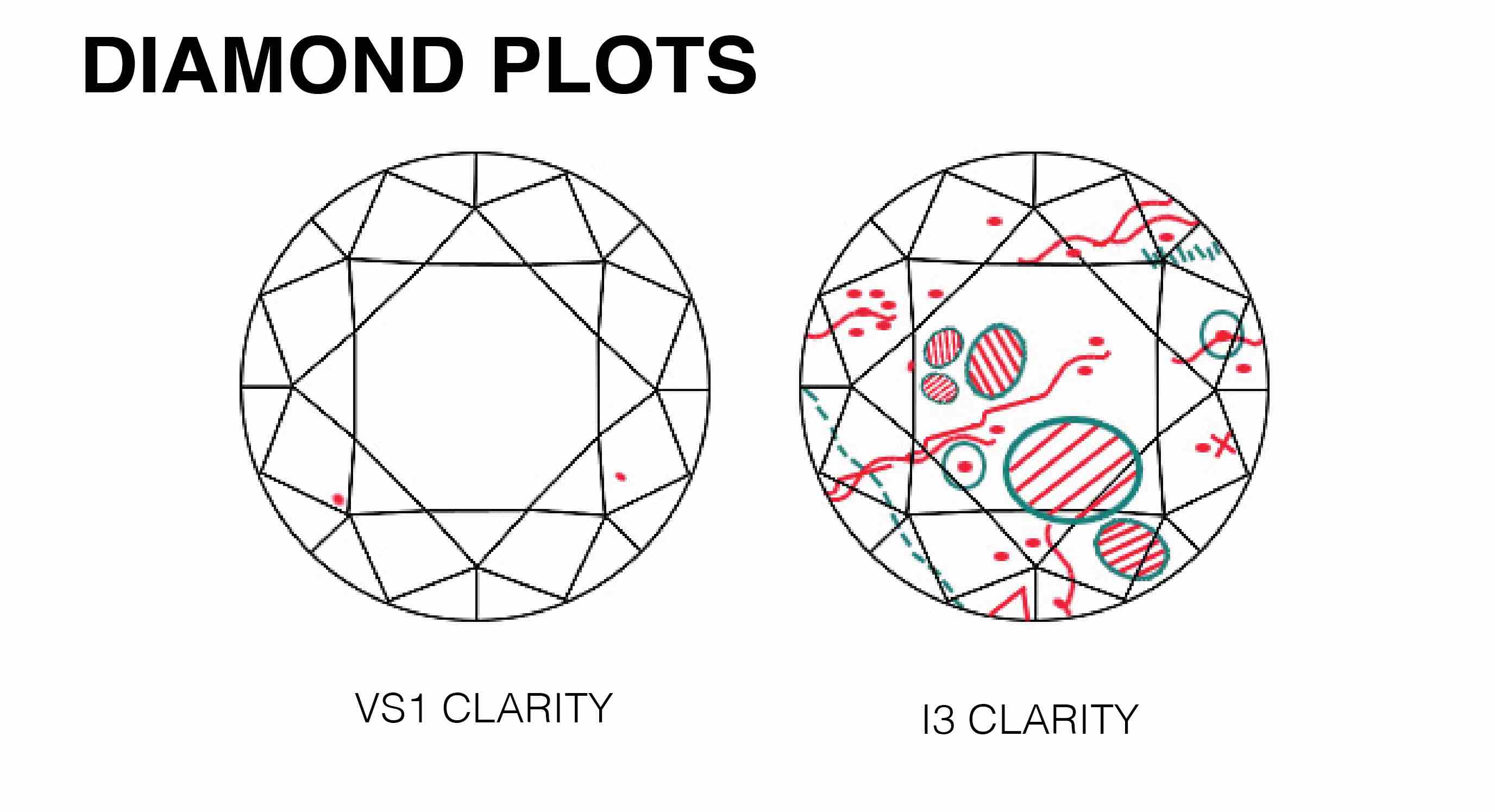
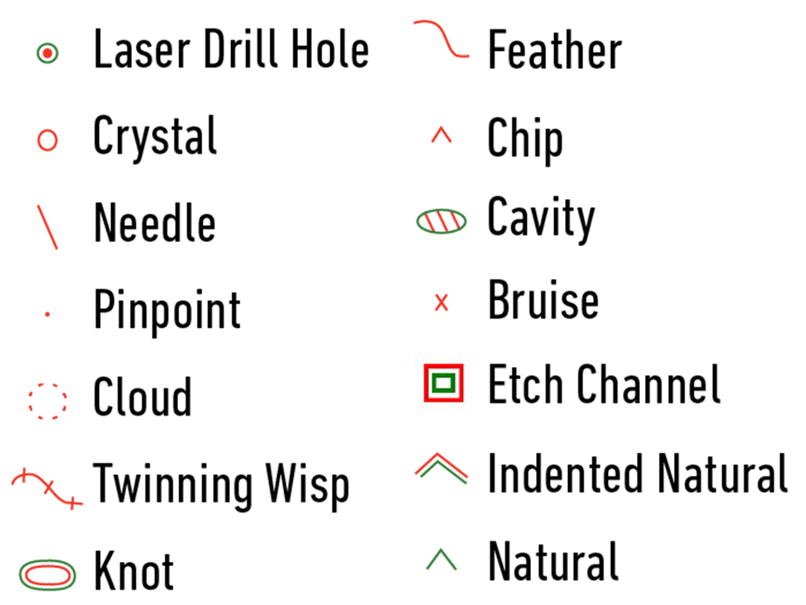
If you are seeing this diagram for the first time, do not be alarmed, some details might seem complicated and hard to comprehend for a beginner diamond collector. This is the reason why I have written this article, to explain each symbol and types in detail for you to understand.
In this section, I will go over the 11 most commonly seen flaws (Image from GIA). These flaws may or may not affect the beauty of the diamond gem, I tend to rely on both the certification and the inspection of the real diamond every time I buy a diamond.
1. Bearding
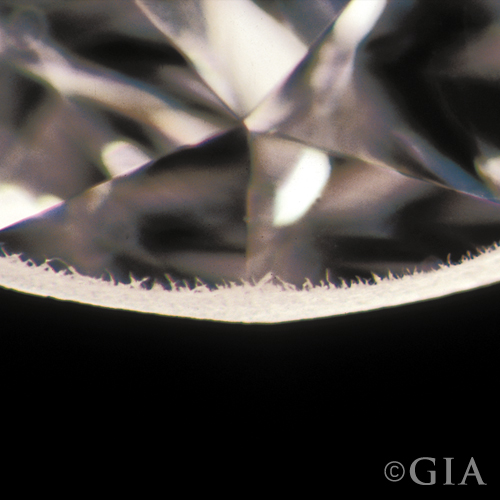
The shape of a “bearding” is similar to a string of hair, it is formed in the Girdle (edge of the diamond) during the process of “bruting” or the cutting of a diamond by placing 2 diamonds onto different spinning axles and having them grind each other into a round shape.
Bearding is generally an acceptable flaw for me (if the flaw is not too overwhelming) because it does not directly affect the “face” of the diamond.
2. Cavity
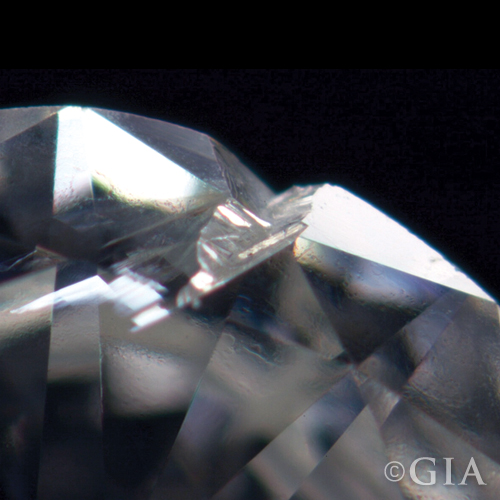
It is an opening that usually happens during the cutting of the diamond. It is commonly caused by the diamond cutter’s attempt to rid of a flaw such as a feather or a crystal, causing a cavity.
This could be compared to squeezing a pimple and then leaving a permanent hole or pockmarks.
If a diamond has a large cavity, when wearing them there might be stains accumulated in the diamond’s cavity – causing that part of the diamond to become permanently black.
But if the diamond has higher clarity levels such as VVS1-VVS2, I might consider this type of flaw on a case-by-case basis.
3. Chip
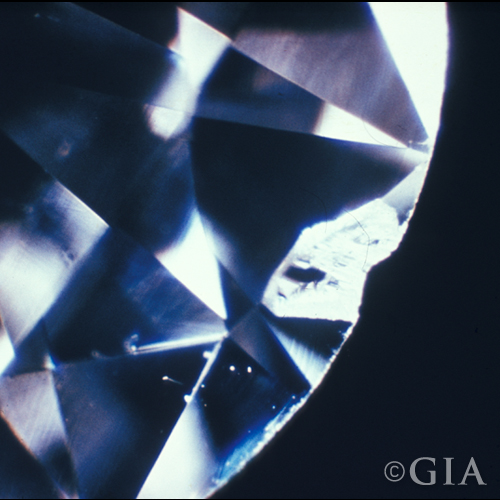
A chip is a part of a diamond that has fallen off, it is commonly found in the rim or the bottom of a diamond.
The main causes of a chip are from careless wearing and usage of a diamond (serious impact on a hard surface) or it could be caused by a mistake of an inexperienced diamond setter. This will directly affect the carat weight of the diamond.
This type of flaw is commonly found in secondhand diamonds or diamonds that are taken to issue a certificate after a long time of wear.
4. Cloud
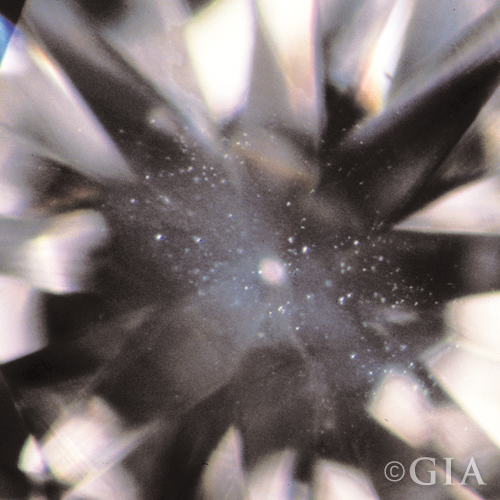
This is also a commonly found flaw and is a terminology used in extensive context. It refers to the clumping of a pinpoint or a crystal.
Usually, if the cloud is scattered in small groups on different points, it is considered normal and should cause no worries.
In some cases, if the clouds are too prevalent, it could severely affect the brilliance of a diamond – causing it to look cloudy and unreflective to light. The industry insiders call this type of diamond “Milky” which is something collectors should avoid. These diamonds will lose a lot of value and market liquidity.
5. Crystal
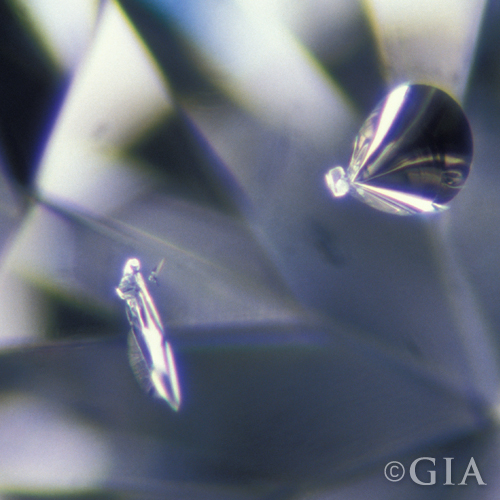
Crystals are natural minerals that are often found inside diamonds. It is common, but it warrants caution.
Because crystals come in various forms such as colorless (diamond parts within the diamond), black (carbon parts), reddish (garnet parts), greenish (peridot pieces), and et cetera. These details are not stated on the diamond report and so it requires a physical inspection on the diamond.
The types of the crystal will directly affect the beauty and the value of the diamond are black and green.
And so it should not surprise you if we see a diamond report of (seemingly) beautiful diamonds at such attractive prices. For example, a diamond with a D-Color grade with a VS1-VS2 clarity level that also turns out to include a free black crystal. Not good.
Therefore, if your diamond has crystals in it – you should carefully examine the color and location of the crystals.
6. Feather
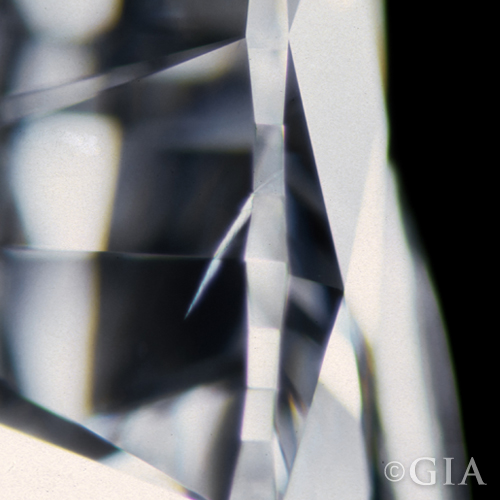
A feather is a small crack or inclusion within the diamond. If you were to ask me how noticeable it is, I would say it depends on the angle we view the diamond at. In some angles, the feather might be so translucent that it is unnoticeable but from another angle, it might be noticeable as a whitish crack when reflecting light.
If your diamond contains too many “feathers” it could directly affect the durability of the diamond (the closer it is to the edge of the diamond, the greater the risk) or it could cause the diamond to have undesirable colors mixed inside.
Feathers will commonly pop up in many diamond certifications, personally I also view this on a case-by-case basis. But I will try to avoid diamonds that have feathers near the edge of the diamond because when used over time, the diamond’s chance to break will gradually increase.
7. Graining
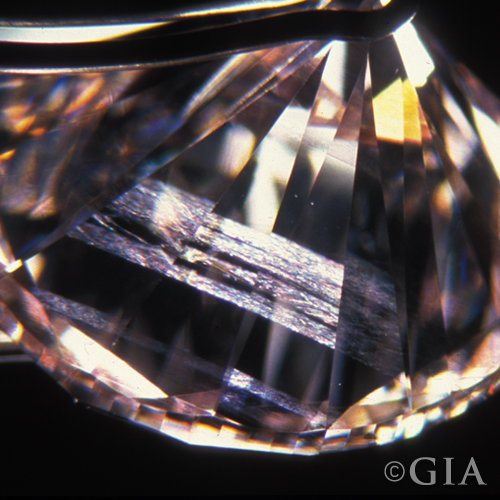
This is caused by abnormal growth of the crystals within the diamond, this type of flaw could come in many forms such as colorless, colored, or scratchy lines. If there are too many of this, it could cause your diamond to look wrinkled like an unironed piece of clothing and could potentially cause the diamond to look muddled.
Generally, if there are grainings on the bottom part of the diamond – it is considered good luck. If the graining appears on the top parts of the diamond, we will have to take another look at it to see what type of graining it is and how much it affects the diamond.
8. Indented Natural
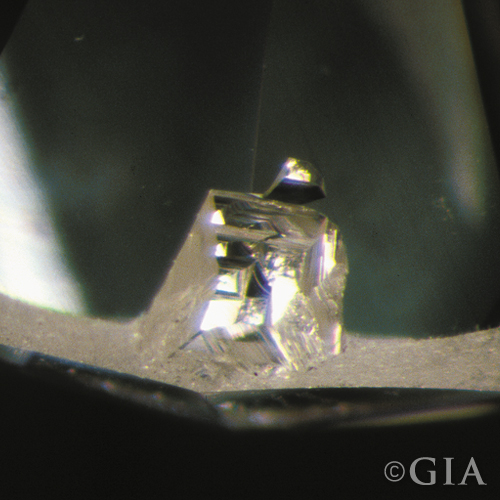
This is a dent that occurs under the surface of a diamond as a result of the diamond’s cutter decision not to scrub it off. It is commonly found on the edges of a diamond.
Some might mistake an indented natural as a chip, but at a closer look, we will be able to see a clear difference between both of them.
If your diamond has a small indented natural in the edges, do not worry because we can bring your diamond to a skilled diamond setter and he will instantly know to know a prong setting to hide that section as well as to protect the diamond.
9. Needle
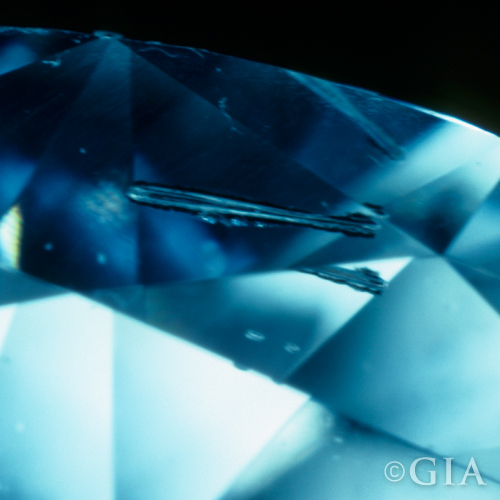
This flaw has the appearance of a long and thin sewing needle, it usually appears as white or colorless. If the needles appear in a cluster, it could potentially directly affect the beauty of the diamond.
If your diamond has a small diamond that does not appear on the “face” of the diamond (also known as the table), it is still considered acceptable.
10. Pinpoint
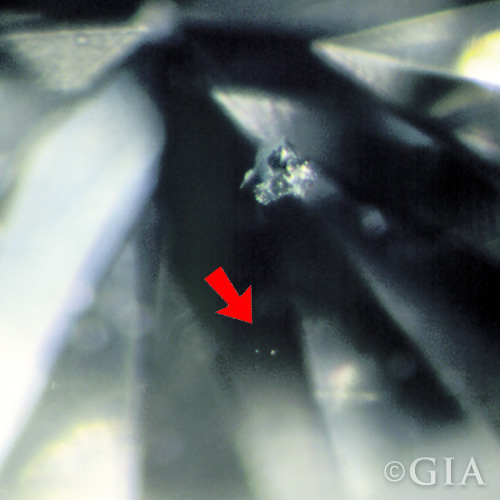
A pinpoint is a small point that appears within the diamond, it can come in black or white. It must have no more than 3 points in the same location as if there are more than 3, GIA will state it as a “Cloud” instead.
Pinpoints are considered minor flaws that do not directly affect the beauty of a diamond (unless it is a black pinpoint that appears on the face of the diamond).
11. Twinning Wisp
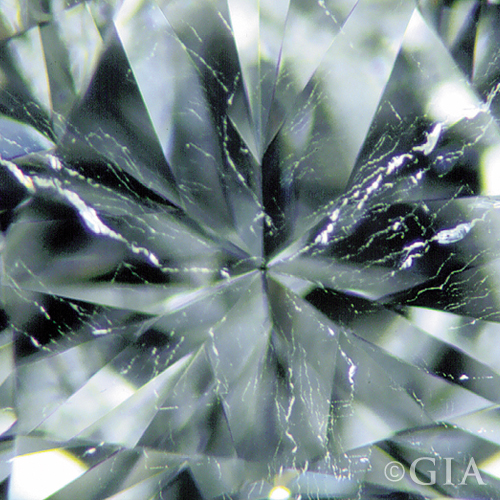
This is the result of abnormal crystal growth during the process of a diamond’s growth. Its characteristics are similar to a tree’s roots.
Generally, we will find twinning wisps on fancy diamond shapes such as the Pear Shape, Heart Shape, and Triangle shape because it is caused by the twisting of the diamond. It can also be found in other shapes of diamonds.
In simpler terms, twinning wisps are a combination of different inclusions such as pinpoints, crystals, feathers, and clouds. It is commonly found in diamonds with clarity levels lower than SI.
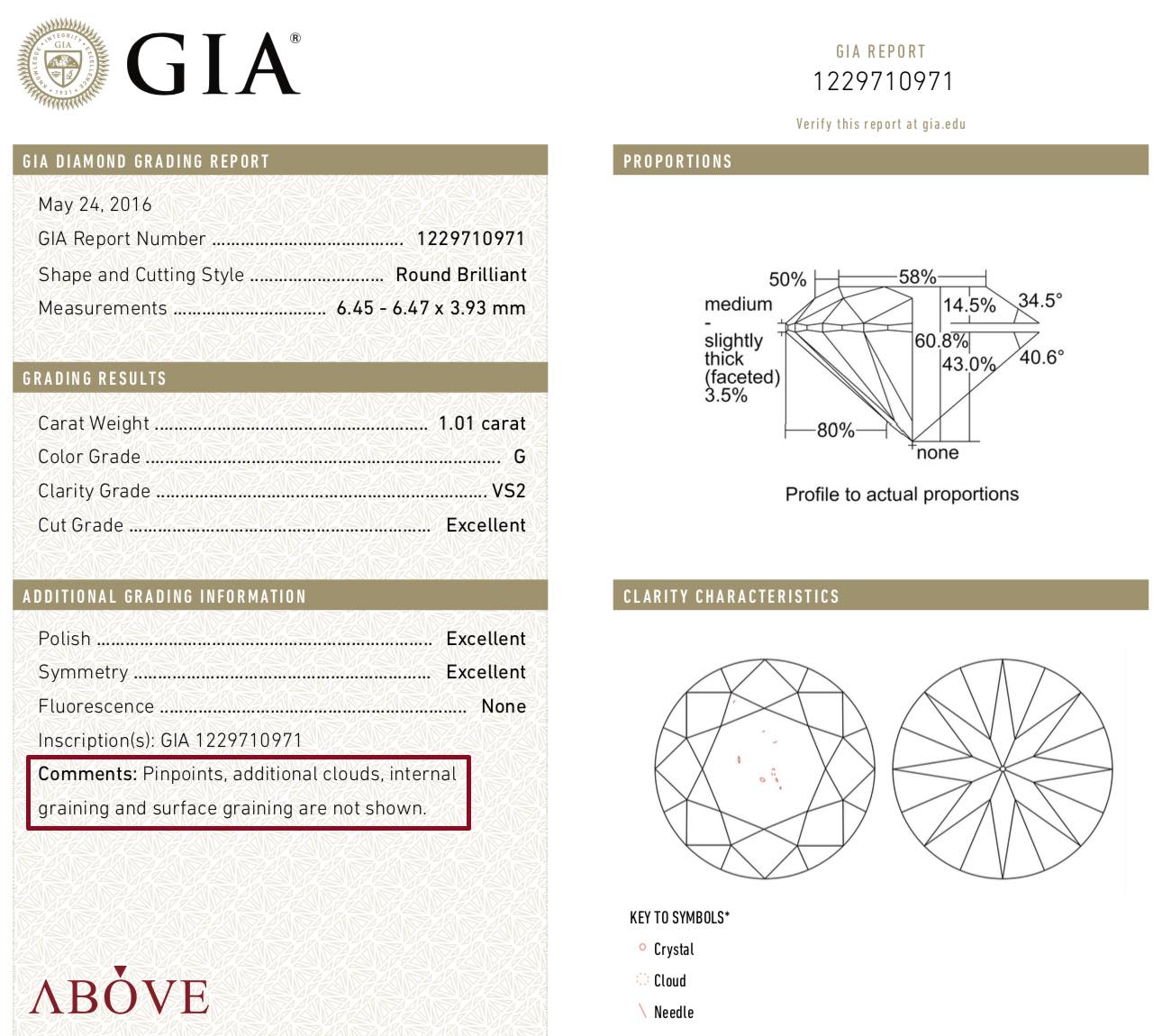
In some cases we might see comments on a diamond certification that says “Not Shown”, most of the time that means that the flaws are minor or not significant enough for the GIA to include it in the diagram. Instead, it will be collected as scores and used in the “Assign Clarity” section.
The 5 types of “Not Shown” Clarity Characteristics that I will talk about are mostly unaffecting towards the diamond. You should not worry if you should find these comments on your diamond report.
1. Additional Clouds/Pinpoints are not shown
Is a diamond that has an insignificant amount of clouds or pinpoints, it is so insignificant that it does not affect the diamond in any way.
2. Surface Graining is not shown
This means that there is slight natural roughness on the surface created during the forming process of the diamond. It is incredibly difficult to be seen even when using a 20x-30x magnifier (10x magnifiers are the standard for examining diamonds).
3. Internal Graining is not shown
Similar to the “Surface Graining” but is instead, inside the diamond. The noticeability of this depends on the angle in which the diamond is viewed and the quality of the lighting (most of the time it is still not visible).
4. Minor details of Polish are not shown
This is a comment that is so commonly found that it is considered normal for IF Clarity diamonds. It does not affect the beauty of a diamond at all, it is the only point that distinguishes IF diamonds from FL (Flawless) diamonds.
5. Additional Twinning Wisps are not show
Commonly found in SI clarity level diamonds, it is caused by the crystals changing growth direction within the diamond during the forming process.
If you are one of those who consider a diamond based solely on Clarity: IF VVS VS SI that appears on the diamond report, having read the article up to this point, you could see why that may not be sufficient to make a decision.
Because you should look deeper into the clarity characteristics or the type of flaws your diamond has, so you are able to see the seriousness of the flaw. The comments should be used as the second stage of an examination, to fully understand the story of said diamond.
However, the answer to the question “Will this flaw affect the beauty of the diamond?” is quite subjective. In the same way, some might have a mole on their mouth and some might have a mole on their nose – some might view the first person as more attractive whilst some may prefer the second person. It all depends on your preference.
And this is the reason why we should carefully select each diamond with care, to ensure that you will be receiving a beautiful diamond that is worth the trust that every single one of our customers has placed on us for over 50 years.
If you have any questions about the “Clarity Characteristic” of a diamond, you can contact us now to receive our advice and consultation.

Get in touch with one of our diamond specialists.
This website use cookies to enhance your experience and providing the best service from us. You can learn more about our use of cookies in Privacy Policy